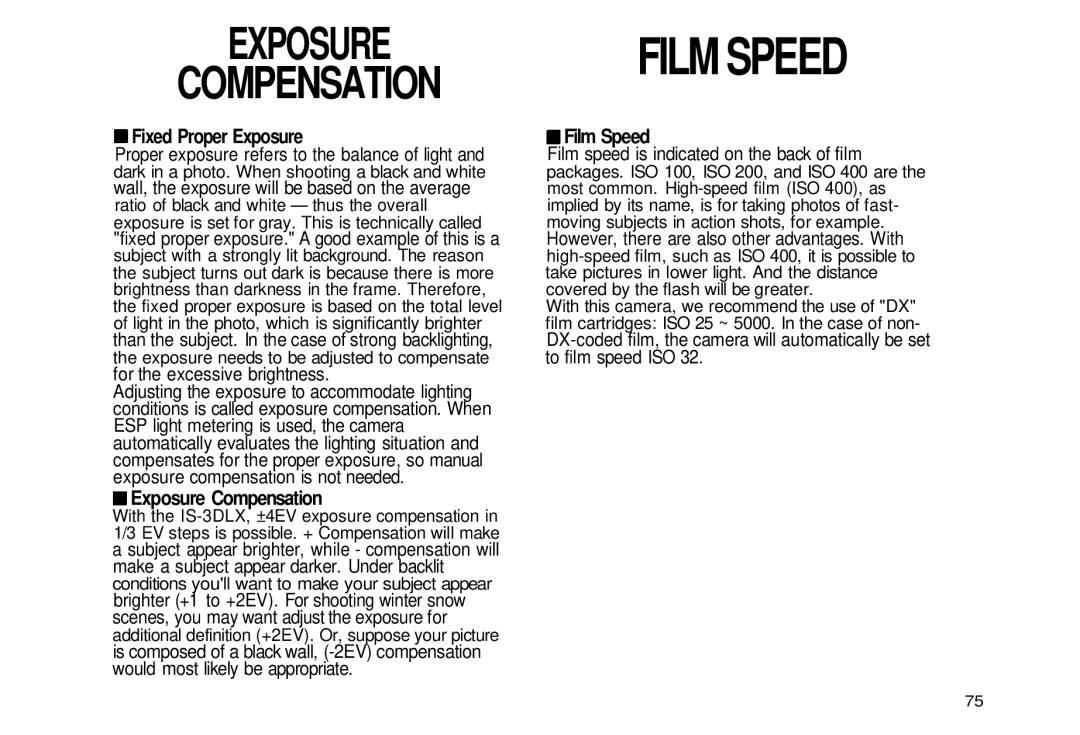Instructions
Blinking Halfway
Depress
Preparations
Selftimer
Remote control sensor front AF illuminator
Power ON/OFF switch
PF button Macro button
Tripod socket Shift buttons
Back cover release
Auto flash Auto-S flash Fill-in flash
Exposure compensation/ Manual exposure
Attaching the Strap
Basic Shooting Procedures
Outline of Operations
Load the batteries p Open the back cover p
Close the back cover p
Depress the shutter release
Button fully to take a picture
Loadingthebatteries
Turn the power switch on
Checkingthebatteries
Lights
Hold the Camera Correctly
Points to Remember
To lock the focus
To release the shutter and take the picture
Make sure
Standard Shooting Mode
Reset Operation
Back cover
Loading the Film
Slide the back cover
Release upward to open
Film loading indicator
Turn the power switch
Close the back cover
Film automatically advances to the first frame
Taking Pictures
Follow the procedure here to cover ordinary photography
Turn the power
Switch on Button to determine Composition
Max. wide-angle focal Length 35 mm
Max. telephoto focal Length 180mm
Lock on, and when the subject is too close
Depress the shutter
Release button halfway
Reach the end of a roll
Camera automatically rewinds the film when you
Unloading the Film
Rewinding the film before End of the roll
Usingthe Focus Lock
Frame, use the focus lock
Make sure Autofocus frame
Flash Modes
Slide the flash release to
Flip up the flash
Press the flash button
Release the flash button to engage the mode
Flash
When the flash is
Flipped up, the camera
Should be used. Slide
Auto Flash Range
Press the shutter release button
Select the Auto-S mode Button
Pre-flashes are not emitted in the Sports mode
Flip up the flash,
Mode. Press the shutter
Make sure the exposure Flip up the flash, Mode is set to P
Program
Release button
Focus and exposure will be locked
Selftimer
Remote control button
Is displayed on
Use a tripod, etc., to hold the camera steady
Press the macro button
Macro Photography
Press the zoom buttons to determine Composition
Usingthe Exposure Modes
There are seven exposure modes four with preset settings
Exposure Modes
Buttons or shift dial
How to Select the Exposure Mode
Select the Sports mode to display on the LCD panel
Sports
To shoot fast-moving subjects
Button
Mode to display on
Portrait
Select the Portrait
Select the Landscape
Mode to display on Release button
Landscape
To take pictures with extended in-focus backgrounds
Select the Night Scene
Mode to display on Button LCD panel
Night Scene
Shooting Night Scenes Free of Subjects
Engage the Night Scene Mode. Flip up the flash. Press
Shutter release button
APERTURE-PREFERRED Auto a
Larger aperture
Smaller aperture
500-sec
Slower shutter speed 60-sec
Display M on the LCD
Adjust the aperture
Manual Exposure M
Panel
Viewfinder
Adjust the shutter Be displayed on Speed
Turn the shift dial to
Exposure level will
Table below
Zoom Macro
Distance
While pressing the +
Exposure Compensation
Drive Modes
Usingthe Drive Modes Drive
Selecting the Drive Mode
There are two film-advance modes in addition to
Release the drive button
While pressing the drive
While the shutter release
Continuous Shooting
Display D.EXP. on
Double Exposure D.EXP
Button fully to take
First exposure
Cannot be canceled after the first shot
Power Focus
Picture
Spot Metering
This exposure method is most effective when
Zoomexposure
While keeping the zoom
Button depressed, press
Fully to take the picture Buttons again
Press the selftimer/remote
Control button to engage On the subject Remote Control mode
Press Display
Transmission is blocked by the converter
Use selftimer outside this range
Use the provided viewfinder
Viewfinder Cap
Cap to prevent light from entering the viewfinder
Bulb
Press the button on the remote control
Press the button on the remote control again
Printing the Date and Time
Make sure The data to be corrected is blinking
After setting the data
Press the Date Mode button again
Correcting the Data
Flash
Distance between the xenon tube and tne
A reflective backing that are ideal for both wide
Brightness between that of the subject
Conditions
ON, set the cameras
When shooting in the Shutter-Preferred Auto mode
Exposure mode to S Using the shift dial
Turn the power switch Select 1/100-sec. or
Press the shutter release button
Built-in flash
Advanced flash photography using the G40
Multi Flash
Follow-Synchro
Greater than at 35 mm, for genuine telephoto
A zoom lens, the focal length is changed by
Be selected Mm wide-angle
At 35 mm More than 100 mm
That the camera is able to bring into focus.
Angle of view and depth of field
Vertical lines Light Use the focus lock by first
Power focus to manually focus on Subject
Autofocus AF
Subjects with low contrast Subjects that do not contain
Set in advance
Two subjects at different distances
Sense of motion
Standard photography mode refer to p , if
Film, and is controlled by a combination
Your shot and releasing the shutter at just the right time
When shooting night scenes you may sometimes
Shooting a subject with a night scene as its
Most suitable exposure compensation for both
Automatically when in the P Program mode
On programmed data to properly compensate for
System is automatically
Film speed is indicated on the back of film
Proper exposure refers to the balance of light
Wall, the exposure will be based on the average
For the excessive brightness
Making it ideal for macro photography beginners
Function, which can fill the frame with an area
This is a close-up lens that lets you fill the frame
Converter can be used with the Aperture-Preferred
Panorama Photography Optional
Grip Strap B
Accessories Optional
Care and Storage
Battery Handling
See
Troubleshooting
Remove the film
Camera closer to the subject
Contrast blue or black
Rewound film is still loaded Viewfinder lights
Subject was backlit
Symptom
Camera
Not positioned on the subject
How long will the batteries last?
Questions and Answers
Frame, panorama marks, autofocus
Specifications
Ft, Tele 1.2 ~ 7 m 3.9 ~ 23 ft with ISO
Olympus OPTICALCO. Europa Gmbh
